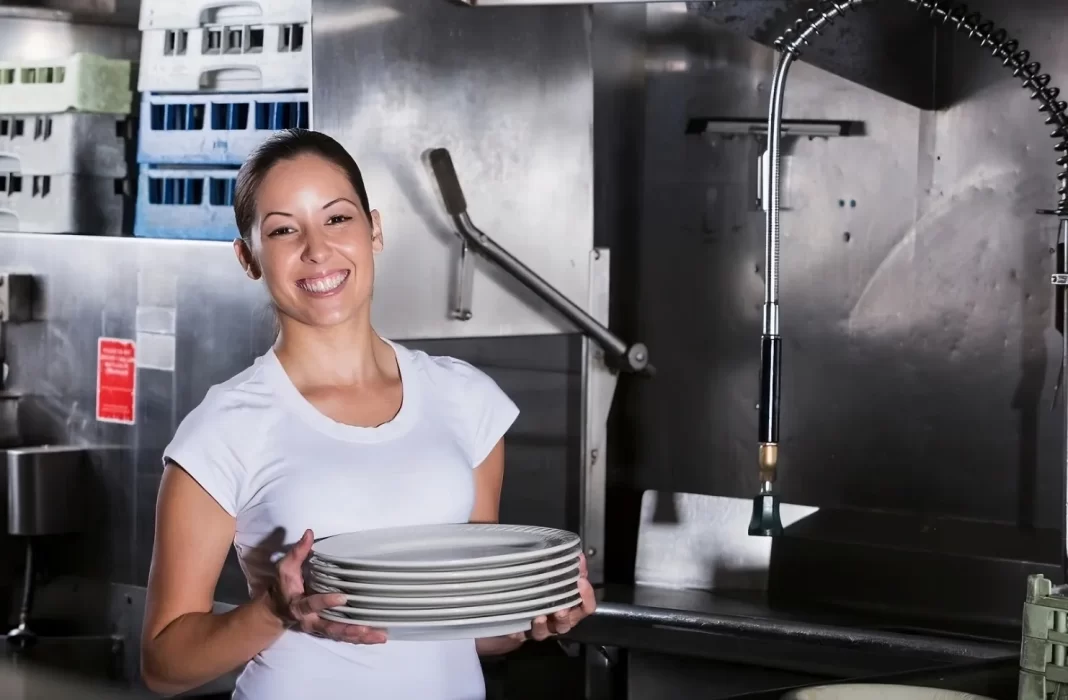Dinnerware is a critical operational asset in any restaurant. Its durability, design, and functionality directly affect food presentation, portion control, service efficiency, and cost management.
Choosing the right commercial dinnerware ensures consistent table settings and withstands high-volume use without compromising quality or appearance.
Now, the question is: How to choose restaurant crockery? This article offers a checklist to help you make informed purchasing decisions.
Types of Restaurant Crockery
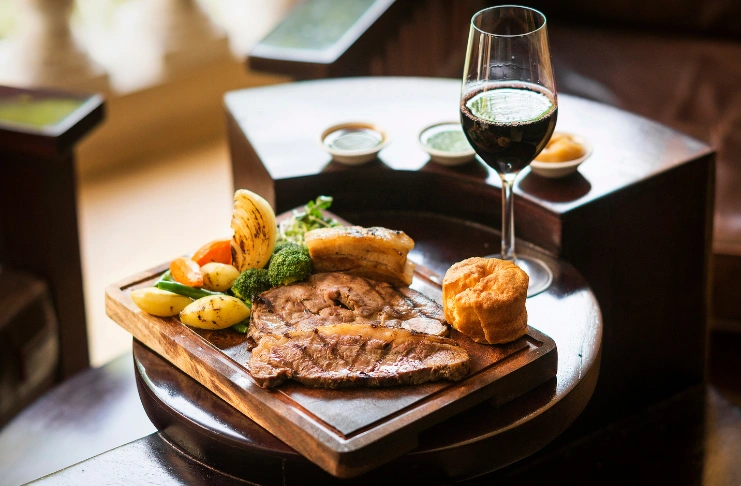
Understanding the different types of crockery available is the first step to choosing the best fit for your restaurant’s needs. Each material has unique characteristics that impact food presentation, durability, and maintenance.
Here’s a detailed look at the different types of restaurant crockery and their applications.
Bone China Dinnerware
Bone china is one of the most refined and high-quality restaurant crockery. Made with porcelain and bone ash, it is lightweight yet incredibly strong. Its translucent and smooth finish gives it a luxurious appeal, making it a popular choice in upscale dining. However, due to its delicate nature and high cost, it requires careful handling.
Porcelain Dinnerware
Porcelain crockery is known for its durability and classic appeal. Fired at high temperatures, it has a non-porous surface that resists stains and absorbs minimal moisture. It is versatile and suitable for both fine dining and casual settings. While stronger than bone china, it can still be prone to chipping if not handled properly.
Earthenware
Earthenware is a traditional form of crockery with a rustic, earthy aesthetic. Made from clay fired at lower temperatures, it has a porous texture and is often glazed for waterproofing. Its affordability and warmth make it an attractive choice for theme-based restaurants serving organic or traditional cuisines. However, it is less durable than porcelain or stoneware.
Stoneware
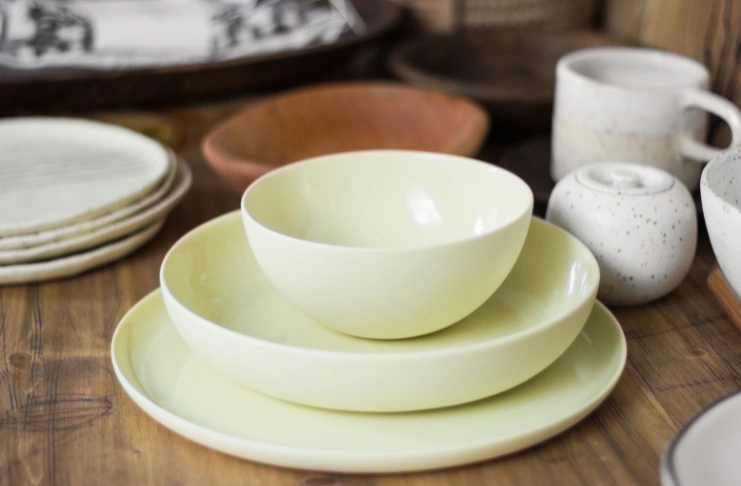
Stronger than earthenware, stoneware is fired at higher temperatures, making it highly durable and resistant to chipping. It retains heat well, making it ideal for serving hot dishes. Stoneware crockery is popular in casual and mid-tier restaurants, offering both functionality and visual appeal with its textured designs.
Melamine
Melamine dishes are practical for fast-paced restaurants, buffets, and outdoor dining setups. Made from hard plastic, they are shatterproof, lightweight, and easy to clean. While they lack the elegance of ceramic crockery, their durability and affordability make them an excellent choice for high-volume service.
Glassware
Glassware is used in restaurants to serve beverages, desserts, and specialty dishes. Its transparency provides an elegant presentation, making food and drinks more visually appealing. However, stylish glass requires careful handling and is prone to breakage. Tempered glass options offer enhanced durability and heat resistance.
Terracotta
Terracotta crockery, made from unglazed or glazed clay, gives dishes a rustic charm. It is often used in Mediterranean, Indian, and farmhouse-style restaurants. Terracotta crockery effectively retains heat, keeping food warm for longer periods. However, it requires careful maintenance as it is porous and may absorb liquids if not properly sealed.
Alumina-Enriched Crockery
This specialized form of ceramic crockery is infused with alumina to enhance strength and durability. It is chip-resistant and designed to withstand rigorous restaurant use. Its creamy finish and durability make it a preferred choice for high-traffic dining establishments and catering services.
How to Choose Restaurant Crockery: Key Factors That Matter
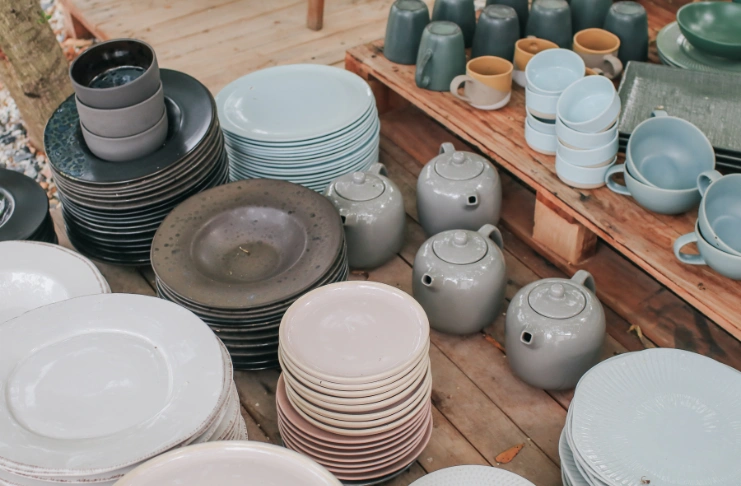
In a commercial dining space, every plate must pull its weight: withstand constant handling, endure industrial dishwashers, and maintain its finish through hundreds of services. This is where most aesthetic-first choices fall short.
Start with durability. Materials like porcelain, melamine, and stoneware are designed for high-volume operations. Ceramic dinnerware, particularly porcelain dinnerware, offers the best balance of strength and presentation for casual restaurants and fine dining establishments.
In contrast, plastic dinnerware may work for fast food restaurants but rarely holds up in settings that demand visual appeal or consistency.
Then there’s functionality. Is the dinnerware dishwasher safe? Microwave safe? These two features alone can significantly impact back-of-house efficiency. For instance, melamine dinnerware is nearly unbreakable and dishwasher safe, but it’s not microwave safe, making it less versatile in specific service formats.
Portion control is another overlooked variable. Oversized dinner plates distort portion sizes and increase food costs, while undersized salad plates or soup bowls can do the opposite, hurting the guest experience. Choose plates that align with your portioning strategy, especially for individual servings like appetizers and desserts.
Lastly, consistency matters. Whether serving on square plates, round plates, or textured stoneware dinnerware, the visual rhythm of your table setting affects both plating efficiency and brand perception. So, choose wisely, and stick to it.
Top 5 Commercial Dinnerware Brands to Consider
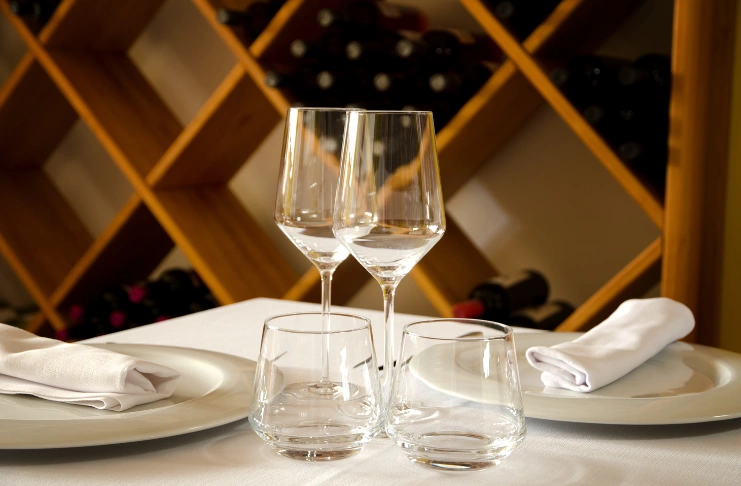
Not all restaurant plates are created equal. Some brands are engineered for fine dining restaurants. Others specialize in durable dinnerware built for fast-paced, high-volume service. Here are trusted names in the commercial dinnerware space:
Libbey
An industry staple, Libbey offers a wide range of ceramic dinnerware, including stackable dinner plates, salad plates, and soup bowls. Known for clean lines and classic shapes, it’s widely used in casual and fine-dining restaurants alike. Their porcelain dinnerware holds up under heavy use while maintaining a refined look.
Homer Laughlin
Homer Laughlin’s china dinnerware is made in the U.S. and built to last. It is ideal for operators looking for vibrant colorways without compromising durability. Dishwasher, lead-free, and microwave-safe, these dishes suit both family-style eateries and fast-casual establishments.
Cambro
Best known for its plastic and melamine dinnerware lines, Cambro is a go-to for fast-food restaurants, cafeterias, and high-volume chains. Their products are cost-efficient, scratch-resistant, and designed to handle rough back-of-house environments.
Tuxton
Tuxton’s stoneware dishes are built for rugged, repeated use and come in versatile, contemporary shapes. They’re especially popular among food service businesses seeking durable, microwave-safe options that maintain style without fragility.
Fortessa
For fine dining establishments looking to elevate the table setting, Fortessa offers premium porcelain and bone china dinnerware with a delicate appearance that belies their durability. Their pieces bring high visual appeal and are favored by many upscale restaurants and hotels.
Core Dinnerware Pieces Every Restaurant Needs
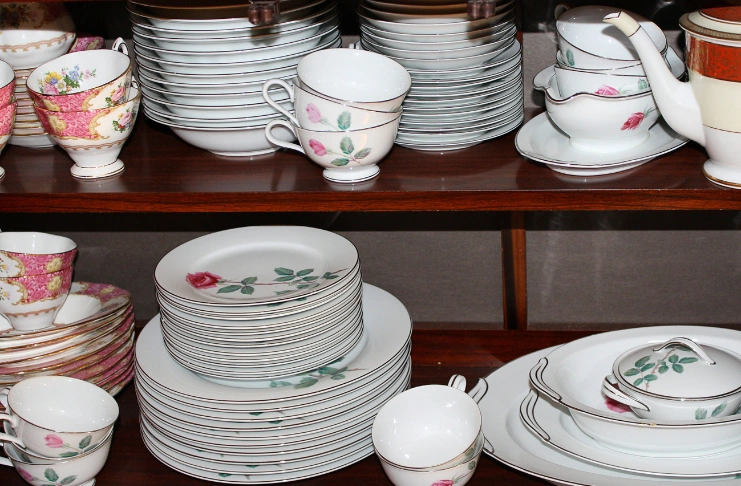
Every restaurant requires a well-curated selection of dinnerware to ensure seamless service and enhance food presentation. Here are the essential pieces that form the backbone of any foodservice business.
Dinner Plates
- The foundation of any table setting. It is mainly used for main courses.
- Available in round plates and square plates, depending on the presentation style.
- Porcelain dinnerware and stoneware dinnerware are popular choices for durability and elegance.
Salad Plates
- Slightly smaller than dinner plates, ideal for serving salads and appetizers.
- Bone china dinnerware offers a delicate appearance while maintaining strength.
- Melamine dishes are a great option for casual restaurants due to their durability.
Dessert Plates
- Designed to serve sweet treats and small portions.
- Glass dinnerware enhances visual appeal, making desserts look more enticing.
- Fine dining restaurants often opt for china dinnerware for a refined touch.
Soup Bowls
- Essential for serving soups, stews, and broths.
- Ceramic dinnerware retains heat well, ensuring optimal serving temperatures.
- Microwave-safe and dishwasher-safe options improve usability.
Appetizer Plates
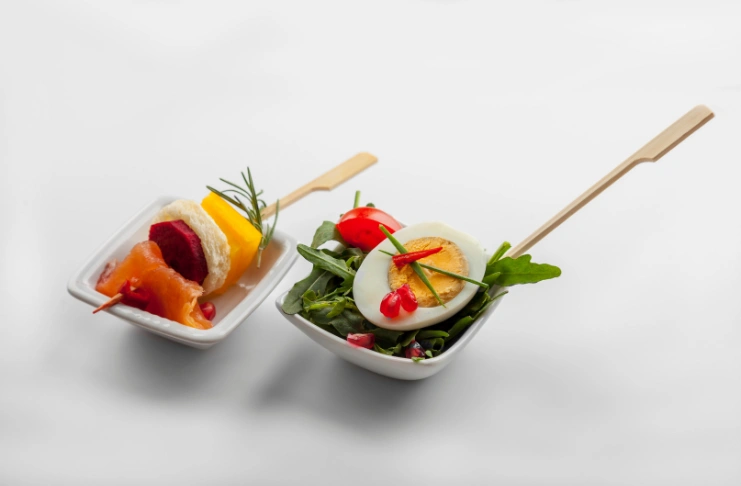
- Used for starters, tapas, and small bites.
- Plastic dinnerware is a budget-friendly option for fast food restaurants.
- Porcelain dishes add sophistication to upscale dining experiences.
Bowls for Side Dishes
- Perfect for serving rice, pasta, and other side dishes.
- Durable dinnerware ensures longevity in high-volume restaurants.
- Non-porous materials prevent staining and odor retention.
Specialty Plates & Bowls
- Unique shapes like oval or rectangular plates add visual interest.
- Fine dining establishments often use bone china for an upscale feel.
- Dishwasher-safe options reduce maintenance efforts.
INDUSTRY INSIGHT
| Studies show that over 70% of diners prefer establishments that prioritize eco-friendly practices. This shift has led many restaurants to replace traditional plastic and paper dinnerware with compostable plates, cups, and cutlery. Benefit? According to the life cycle assessment published in Environmental Science & Technology, compostable food service ware reduces carbon emissions by 43% and non-renewable energy consumption by 28% compared to conventional plastic alternatives. Plus, compostable materials prevent millions of pounds of waste from entering landfills annually, making them a compelling choice for restaurants looking to lower their environmental footprint while cutting disposal costs. Beyond environmental benefits, sustainability is proving to be a smart business move. With 57% of customers actively seeking eco-conscious dining options, restaurants that embrace compostable dinnerware contribute to a greener planet and attract a loyal customer base willing to pay more for sustainable choices. |
Conclusion
The right dinnerware fits your expectations and restaurant needs. It sustains service, controls costs, and shapes how food is received. Choose wisely, and make each piece work for your kitchen, staff, and brand. Remember: utility and impression are never separate in the kitchen.
Frequently Asked Questions
1. Which crockery is best for a restaurant?
Commercial dinnerware made from porcelain or stoneware is widely preferred for its durability, appearance, and dishwasher-safe properties.
2. How to choose plates for a restaurant?
Choose plates based on durability, portion sizes, service style, and ease of maintenance. Depending on your concept, prioritize materials like porcelain, bone china, or melamine.
3. What is the best dinnerware for restaurants?
The best dinnerware balances form and function. Porcelain and stoneware dinnerware are popular for their durability and clean lines.
4. What type of dinnerware do restaurants use?
Many restaurants use a mix of porcelain, bone china, melamine, and ceramic dinnerware based on their service model and food menu.
5. What is the best commercial grade dinnerware?
Commercial dinnerware that is scratch-resistant, dishwasher safe, and chip-resistant (like vitrified porcelain or melamine) is considered top-tier.
6. What are the different types of crockery?
Key types include dinner plates, salad plates, dessert plates, appetizer plates, soup bowls, and side dishes, which are made from materials like porcelain, melamine, bone china, and plastic.
7. What crockery is used in restaurants?
Restaurants commonly use durable dinnerware, such as porcelain, melamine, and stoneware, designed to serve meals efficiently under high-volume use.
8. What are the 4 types of tableware?
The four categories of tableware are dinnerware, flatware, glassware, and serveware, each contributing to a functional table setting.


